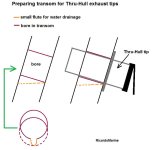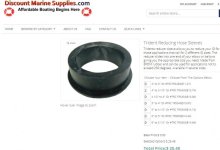sandkicker
Outstanding Contributor
The critical dimension, no matter how you measure it ( the Merc manual just shows a convenient way to measure it referenced to the top of the gunwales, a spot that can be referenced accurately from both inside and outside the boat) is that the top of the elbows should be at least 13 inches above the water line. This number is totally determined by the layout of the engine. Normally Volvo 200 series drives sit such that the top of the drive case is just above the laden water line and the height of the elbows is set by the layout of the engine. That said, it is unlikely that your elbows are 18" above the water line unless there is a spacer under the elbows on the manifold. Measure waterline to highest point on transom, and from the highest point of the transom back down to the elbow.
Exit point on transom... You want it such that there is at least a 1" per ft "downhill", more if possible. Most hulls nose down when the throttle is cut suddenly and you don't want the water in the exhaust line to run "down hill" back into the engine under that circumstance.
Exit point on transom... You want it such that there is at least a 1" per ft "downhill", more if possible. Most hulls nose down when the throttle is cut suddenly and you don't want the water in the exhaust line to run "down hill" back into the engine under that circumstance.
Last edited:




